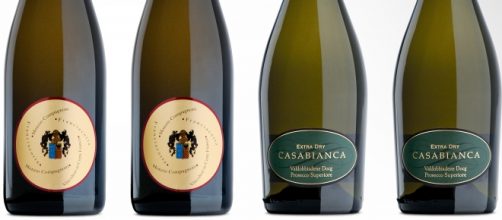For the first time, last year the Italian Spumante Prosecco sold more bottles than French Champagne in the UK. However, it is not time yet for Prosecco to rest on laurels, as another Italian sparkling wine is gaining momentum: the Franciacorta.
We are far from saying that these two wines are similar: Spumante Prosecco and Franciacorta are actually quite different. Not only the grapes used, but also the winemaking methodsdiffer: the Charmat (or Martinotti) method for Prosecco, by one side, and the Champenois method for Franciacorta, by the other.
Prosecco is produced within a relative small area of nine provinces in North-Eastern Italy: Belluno, Gorizia, Padova, Pordenone, Treviso, Trieste, Udine, Venezia (yes!) and Vicenza.
Only the sparkling wines bottled by following the detailed statutory requirements can be labelled as Prosecco DOC. One of the main conditions is for at least 85% of the grapes used for production to belong to the Glera variety, while the remaining can be Verdiso, Bianchetta trevigiana, Perera, Glera lunga, Chardonnay, Pinot Bianco, Pinot Grigio and Pinot Nero (White Pinot Noir).
Also, Prosecco must be produced by using the Charmat (or Martinotti) method. It is a technique whereby the second fermentation happens in a steel tank; it is the stage when yeasts and sugar are added to the base wine, so that the added yeasts convert the added sugar into alcohol and carbon dioxide bubbles (thus creating the fizzing).
The process was first devised by the Italian enologist Federico Martinotti at the end of the 19th century and subsequently patented in 1907 by French winemaker Eugene Charmat.
A great example of this Spumante available on Libiamo is the Prosecco Valdobbiadene DOCG Superiore Extra Dry by Casabianca, a winery run by the Manin family. In 1906, the Manins started to plant their first Prosecco vines in a sunny valley of the Montello hills, near Treviso. The winery takes its name (“Casabianca”) from a wonderful white house situated in the highest hill of that property overlooking all the vineyards. It holds a low 11% alcohol content. With a fine-grained perlage and a light straw-yellow color, the Prosecco Valboddiadene Casabianca holds a consistent, extremely pleasant taste, with a recall of the refreshing floral notes already perceivable on the nose.
It is the perfect ingredient for an Italian aperitif.
Completely different is the production method used for Franciacorta: the Champenoise method. Like with champagne, the second fermentation takes place in the bottle. It is definitely more labor-intensive and costly. This is why Franciacortas are usually more expensive than Proseccos.
There are strict statutory guidelines also for the production of Franciacorta. Only Pinot Nero and/or Chardonnay can be used, jointly with max 50% of Pinot Bianco and production must take place within specific areas in the province of Brescia, in Lombardy.
“Sales of Franciacorta in the UK have over than doubled since 2013” says merrily Vittorio Moretti, the newly-appointed chairman of Consorzio Franciacorta, the association of Franciacorta producers.
“However, most of the global sales still take place in Italy and the export is still worth only 9% of the 16 million bottles sold last year”.
So, it is time to discover Franciacorta. Libiamo proposes the champion Franciacorta DOCG Brut by Monzio Compagnoni. An extraordinary sparkling wine, it holds a bold straw-yellow tone, with a fine-grained but persistent perlage. This brut delivers an intense and fresh bouquet on the nose, followed by traditional notes of yeast and citrus to smooth its effervescence. The tasteis intense and long-lasting, making it the perfect match for fish appetizers and roasted meats.
If expectations are met, 2016 will see Franciacorta becoming a credible competitor of French Champagne. It is never too early to start tasting new bubbles to prepare the wine list for the next end-year festivities: why not starting with Franciacorta? Libiamo!

